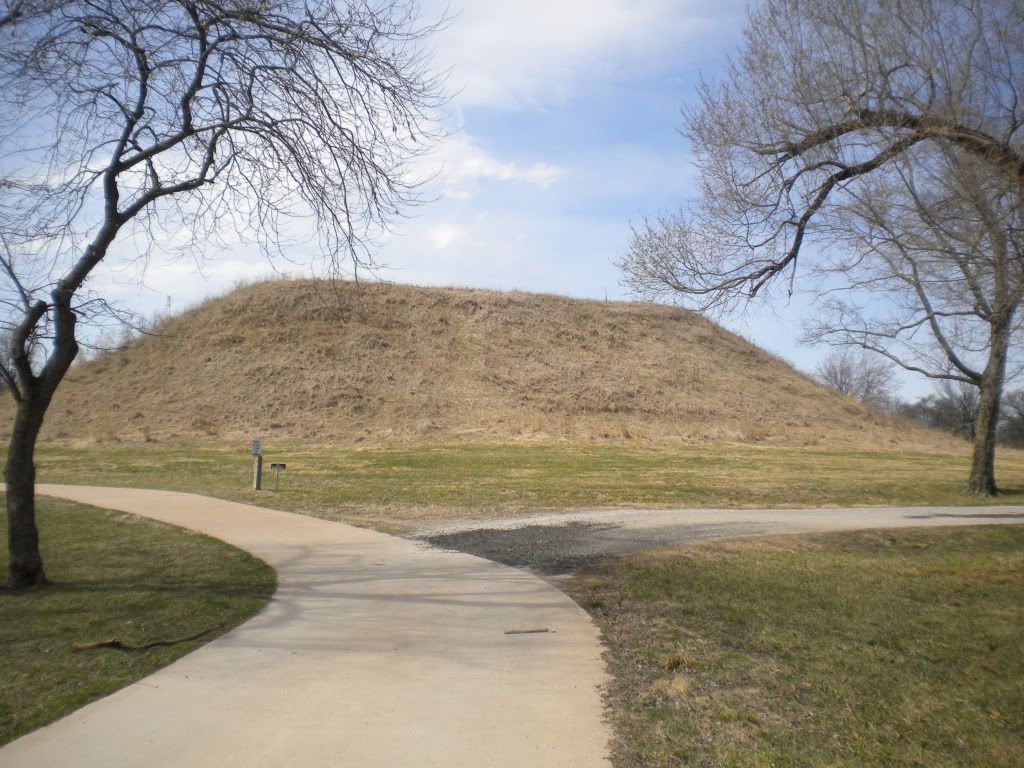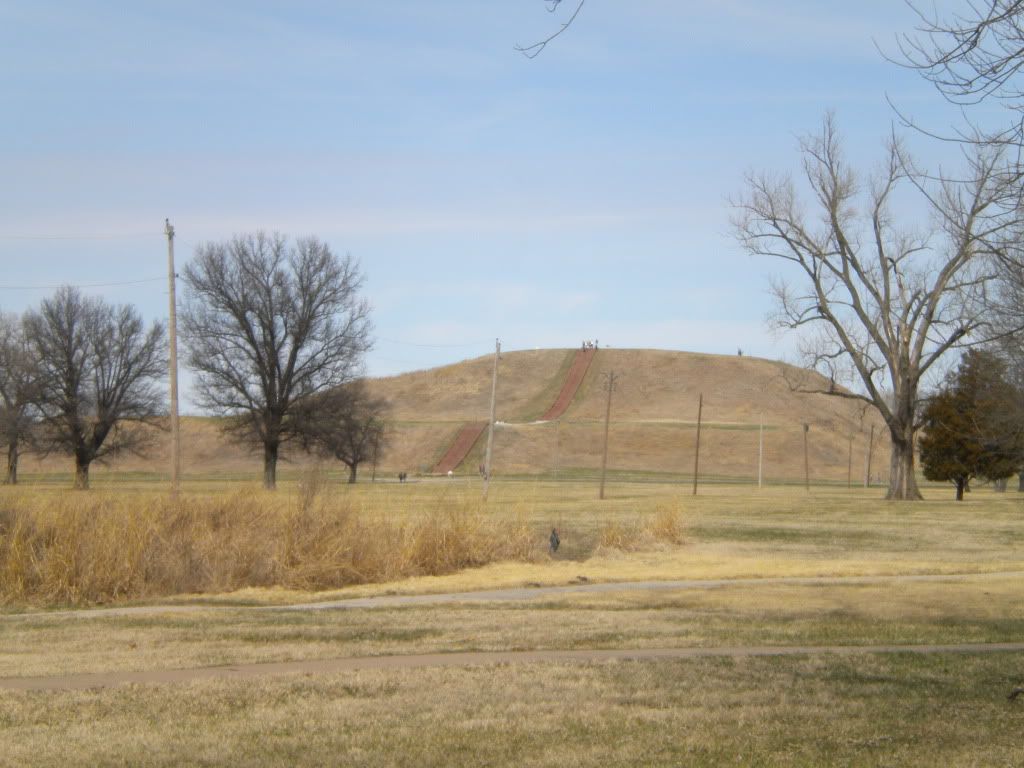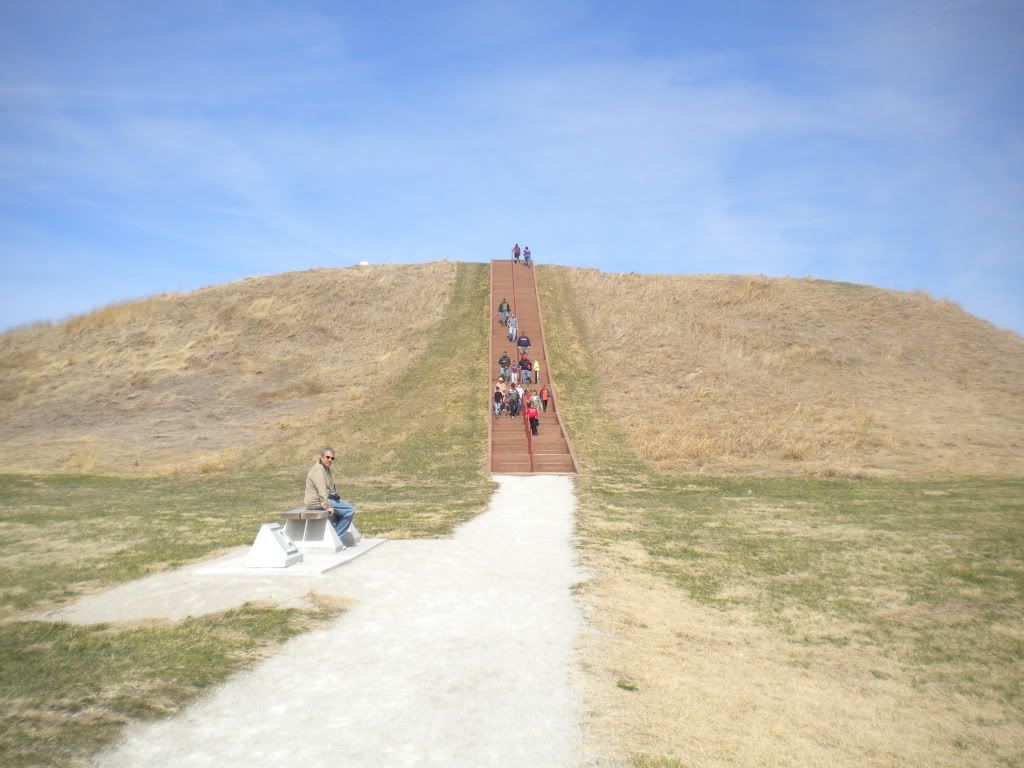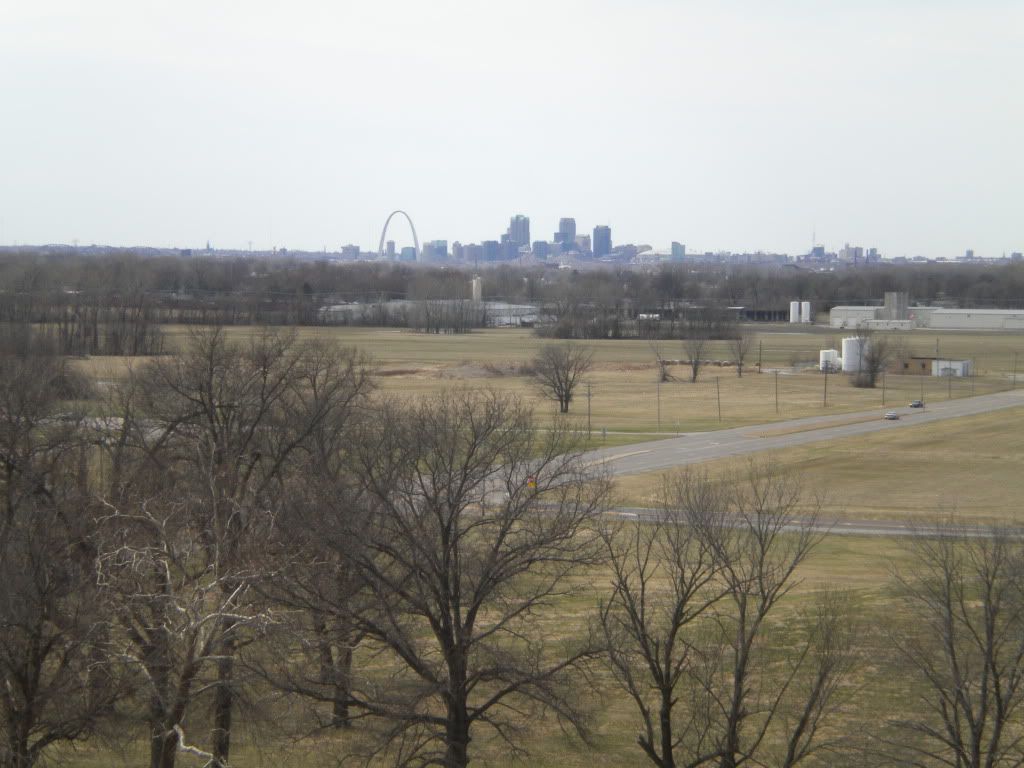He had visited before but since I had never been, he returned with me to explore the site. I will share some of the photos I took while we were there but know that they do not do the site justice by any means!
 |
| A view of the Mississippi from the top of Monk's Mound |
Just as European cities at the time began to see the division of labor and professionalization of skills and trades, researchers have found evidence that a similar division of labor occurred in this settlement (think spear makers, potters, and other crafts people). Yet sometime around 1200, for reasons that are not entirely clear to researchers, the settlement fell into a decline and was completely abandoned by 1400 CE. Some likely causes for this decline include overcrowding, depletion of natural resources, war, disease, social and political unrest or more likely, a combination of these forces that brought about the end.
The word Cahokia is a bit of a misnomer because it refers to a group of native peoples who inhabited the area in the 17th century, long after the settlement had been abandoned. In the mid 18th century, local historians suggested it be called Cahokia Mounds to honor the 16th century natives.
J and I discussed this quite a bit as we were walking around and the popular perception of native peoples is that of nomadic, "uncivilized" people. Places like Cahokia Mounds demonstrate how far this popular opinion is from the truth.
The site itself consists of a museum, gift shop and the grounds themselves. While the natives built over 120 mounds, only one is fully accessible to visitors due to issues with erosion and so forth. As you look through these photos, keep in mind that each of these mounds were created by human hands and tools. Pretty amazing right?!
 |
| One of the many mounds at the site (now a state park). You can see how erosion has taken its toll on these earthen mounds over the centuries. |
 |
| A look as we approach the largest mound, Monk's Mound. The settlement's leader lived and ruled from a wooden structure that was built on the top of this mound. |
 |
| Halfway up Monk's Mound. |
 |
| A view from the top. This gives you a better idea of how big these mounds actually are since we are at least 12-13 miles away from downtown St. Louis. |
 |
| Zoomed in view of Downtown St. Louis from the top of the mound |
This was a great place to visit and I would encourage everyone in the area to check it out, especially as the weather starts to get warmer (hopefully). Since I am not a native of Missouri, I really enjoyed learning more about its history!
Many have compared the settlement to Chichen Itza in Mexico. My question to you is: Have you ever been to Mexico and seen them in person? What about Cahokia Mounds or other local (St. Louis or not) treasures? I'd love to hear (and learn) all about them!

I went to Chichen Itza when I was a kid. It. was. awesome. I've never been over to Cahokia Mounds but based on your photos and other photos I've seen, I don't really think that it can compare. The mounds look awesome, but I just think there's so much more architecturally that went into Chichen Itza. It's all stone. Most of it still is intact enough for people to run up and down the hundreds of steps and even explore inside. It may have gotten more care than Cahokia... who knows. Regardless, you should go some time. You'll be amazed. And I'll go check out Cahokia :)
ReplyDeleteI pass the Mounds every day on my way too and from work but have never been. You were in my neck of the woods! We should get together sometime.
ReplyDeleteWe saw some great artifacts and such when hiking in New Mexico. I have some great photos!
@ Lauren: That's so cool that you got to see Chichen Itza as a kid! I think one thing that hurts Cahokia Mounds is that most of the structures were made with nearby materials, like wood, and so have not lasted the test of time like Chichen. You definitely have to use more of your imagination to "see" what it was like there!
ReplyDelete@ Every Little Thing: Definitely! Emailing you shortly so we can finally meet up :)
At the risk of sounding totally dumb, what is the significance of the mounds and/or what were they built for?
ReplyDelete~Jen
Never been to Chichen Itza but the Mounds? Yup! I'd actually like to go back one day...the last time I went I was just a kid!
ReplyDeleteWOOOOOOOW that is so neat! I was just teaching my World History students about those a few weeks ago.
ReplyDeleteIronically enough I have been to both Chichen Itza and Xcaret, but never Cahokia Mounds.
ReplyDeleteVery cool! They did make me think a little of Chichen Itza when I first saw your pictures, although admittedly I've never been to either place. I loved the view of St. Louis from the top, too!
ReplyDeleteIf you're ever in east OK, check out the Spiro mounds.
ReplyDelete@ Jen: As far as I understand, the mounds had various purposes. A few were burial mounds (sort of like an Egyptian pyramid in that regard), some were ceremonial and researchers have found evidence of buildings on top of others that would have been used for living, worship and so forth. Hope that helps!
ReplyDelete@ Joi: It definitely is a great way to enjoy some sunshine!
@ Miss Lace: That's awesome! I never learned about them in school but I'm glad your students are :)
@ Oonafey: Too funny! Well you should check them out for the trifecta--haha
@ Mrs. W: Thanks! I wanted to stay up there forever because it was so quiet and peaceful :)
@ Mollie: Ooo thanks for the tip! I love checking out historical sites because I'm nerdy like that!